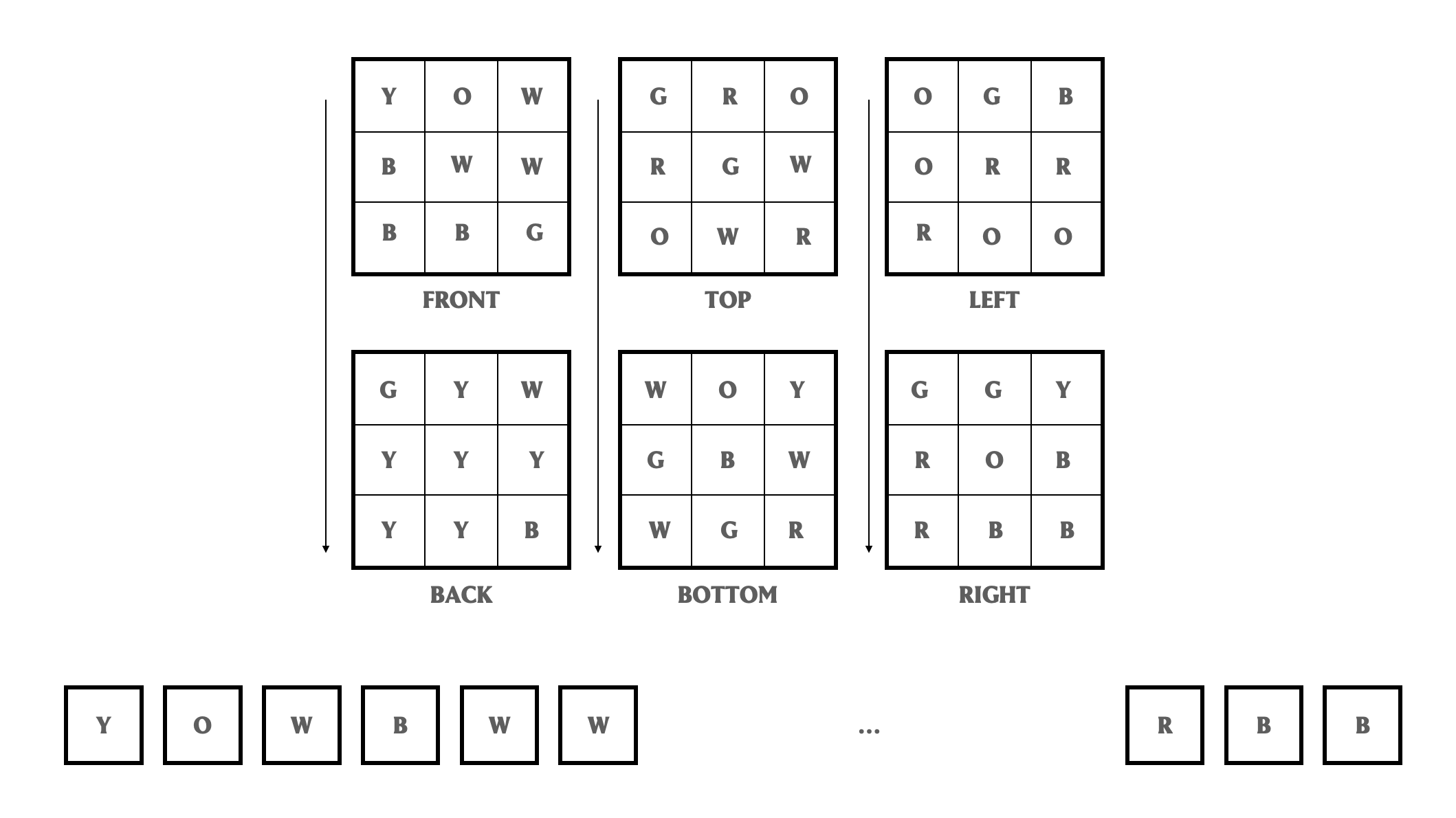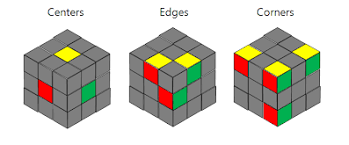ES242. Data Structures and Algorithms I. Exam 01
ES242. Data Structures and Algorithms I.
Exam 01
Issued: 16 Feb, 2023
We will have Exam 1 at the usual classroom venue. The exam will be released on Gradescope by 9:05PM, and will be available until 10:30PM.
All questions are multiple choice or require a numeric answer. Do not enter any explanations for any questions. If required, we will follow up with individual vivas to understand any alternate explanations you had in mind.
You have been asked to rate your confidence for all answers that you give. Please see this slide for the grading scheme and instructions.
Any violations of the honor code (in particular including, but not limited to, communicating during the quiz, or using the internet for anything other than looking up the official course materials) will be reported and will result in a F grade in the course.
The Rubik’s Cube is a 3-D combination puzzle involving a cube with a grid of nine squares on each face. In a solved state, each face of the cube has all the nine squares colored using one of six solid colours: white, red, blue, orange, green, and yellow.

The arrangement of colours is now standardised with white opposite yellow, blue opposite green, and orange opposite red, and the red, white, and blue arranged clockwise in that order.
An internal pivot mechanism enables each face to turn independently, thus mixing up the colours. For the puzzle to be solved, each face must be returned to have only one colour.
Suppose you are implementing a Rubik Cube solver. To answer these questions, you do not need to know how to solve a Rubik’s cube. We assume that the cube is in a fixed orientation, so that that we can identify the front, back, top, bottom, left, and right faces in the natural way.
One natural way to store the state of the cube is to use six 3x3 arrays of chars, with each character representing a color: cube-front[3][3], cube-back[3][3], cube-top[3][3], cube-bottom[3][3], cube-left[3][3], cube-right[3][3].
In this representation, to get the color of the sticker on the top-left corner of the front face, you would check the value of cube-front[0][0].
In general, for a face F, to get the color of the sticker on row R and column C, you will check the value of cube-F[R][C].
Suppose we have a cube is in some state (not necessarily solved), and we want to transform the state to the one the cube would be in if the top face was rotated clockwise. Which array would remain unchanged?
cube-front[3][3]cube-back[3][3]cube-top[3][3]cube-bottom[3][3]cube-left[3][3]cube-right[3][3]
Consider the following approach. Instead of storing six separate two-dimensional arrays, we store the state of the cube as a linked list with 54 entries as depicted below, by listing all the elements in the cube-front array first, followed by cube-back, cube-top, cube-bottom, cube-left, cube-right. The elements within a face are listed row-wise (i.e, all elements of the first row are listed first, second row second, and so on).

Suppose you want to determine the color of a sticker at a particular location, which is specified by the face, row number, and column number. Which approach will require more steps?
- The array approach
- The linked list approach
Consider the linked list approach from the previous question. What is the index of the element that stores the color of the center sticker (i.e, row 1 and column 1 with 0-based indexing) of the bottom face? Assume that the linked list is 1-indexed: for example the index of the element that stores the color of the center sticker for the front face is 5.
Observe that the central pieces of each face in a Rubik’s cube do not move with any of the rotations. We can think of the Rubik’s cube as being assembled from 8 corner pieces and 12 edge pieces as shown below. Each of these individual pieces is called a cubie.

Observe that the state of the cube can be fully specified by specifying the orientation of all the cubies. Fix a labeling of all the corner cubies from 0 to 7 and the edge cubies from 0 to 11.
In particular, let us say that we store the state by storing two orientation arrays and two location arrays.
The first array, C stores the orientation of the corner cubies and the second array E, stores the orientation of edge cubies. The elements of each array stores an orientation (0 or 1 for edges; 0, 1, or 2 for corners).
The third array, CC stores the location of the corner cubies and the fourth array EE, stores the location of edge cubies. The elements of CC are values between 0 and 7 and the elements of EE are values between 0 and 11.
The state can be recovered from the orientations of all the cubies: for example, we know that the edge cubie with label 3 is at the location EE[3], and oriented according to the value stored in E[3].
Which data structure for representing the state of a Rubik’s cube takes up the least space? Assume that we are measuring the space in terms of the total lengths of the sequences involved in each representation.
- the first approach with six 2D arrays
- the second approach using a linked list
- the current approach using two cubie arrays
Consider the representation involving cubies described in the previous part.
Suppose we have a cube is in some state (not necessarily solved), and we want to transform the state to the one the cube would be in if the top face was rotated clockwise. How many values would you have to update in the CC array?
Consider the representation involving cubies described in the previous part.
Suppose we have a cube is in some state (not necessarily solved), and we want to transform the state to the one the cube would be in if the top face was rotated clockwise. How many values would you have to update in the EE array?
Recall that the stable matching problem involves N men and N women. Each man has a ranking of all N women and each woman has a ranking of all N men. A matching M is a collection of N pairs where each pair consists of a man and a woman, and all the men and women appear in exactly one pair. A man a and a woman b are said to block M if a prefers b over his matched partner in M and b prefers a over her matched partner in M according to their respective rankings. A matching is stable if there are no blocking pairs with respect to it.
Suppose X and Y are two stable matchings. For a man a, let X[a] denote the matched partner of a in the matching X and let Y[a] denote the matched partner of a in the matching Y.
Consider a matching Z formed as follows: pair up each man a with the woman he prefers more between X[a] and Y[a].
Note: If X[a] and Y[a] happen to be the same woman b, then pair a with b.
What can we say about Z?
- Z is not necessarily a matching.
- Z is a matching but not necessarily stable.
- Z is always a stable matching.
Suppose X and Y are two stable matchings. For a man a, let X[a] denote the matched partner of a in the matching X and let Y[a] denote the matched partner of a in the matching Y.
Consider a matching Z formed as follows: pair up each man a with the woman he prefers less between X[a] and Y[a].
Note: If X[a] and Y[a] happen to be the same woman b, then pair a with b.
What can we say about Z?
- Z is not necessarily a matching.
- Z is a matching but not necessarily stable.
- Z is always a stable matching.
The memory of Rubina’s computer contains two interesting things: an array of integers and a virus. Each midnight the virus becomes active. It takes each array in memory and replaces it with a bunch of new arrays: one for each contiguous subarray of the original array.
For example, if today the memory contains a single array (1,2,1,3), tomorrow it will contain the following arrays: (1), (2), (1), (3), (1,2), (2,1), (1,3), (1,2,1), (2,1,3), (1,2,1,3).
As another example, if today the memory contains a single array (7,7), tomorrow it will contain the following arrays: (7), (7), (7,7), and the day after tomorrow it will contain the following arrays: (7), (7), (7), (7), (7,7), and so on.
You are given Rubina’s original array A and the number of days D. Let f(A,D) be the sum of all elements of all arrays that will be in the memory of Rubina’s computer after D days. Our goal is to calculate f(A,D). You may assume that the memory of Rubina’s computer is sufficiently large to accommodate all the arrays.
For example, if A is the array (1,2,1,3) and D = 0 then the answer is 7.
If A = (1,2,1,3) and D = 1, what is f(A,D)?
If A = (500) and D = 120, what is f(A,D)?
If A = (1,2) and D = 10, what is f(A,D)?
If A has four elements, how many arrays of length one are there after two steps?
::: Problem 4. A Bit of a Graph
The bit strings of length four are given by:
0000, 0001, 0010, 0011, 0100, 0101, 0110, 0111, 1000, 1001, 1010, 1011, 1100, 1101, 1110, 1111.
Consider a graph where we have:
- a vertex for every bit string of length four, and let us say that the bit string associated with a vertex u is denoted by b_u; and
- an edge from u to v if the corresponding bit strings are such that the last three bits of b_u is the same as the first three bits of b_v.
For example, we will have an edge from the vertex representing 0010 to the vertex representing 0101. We will also have an edge from the vertex representing 0010 to the vertex representing 0100.
How many vertices does this graph have?
How many edges does this graph have?
How many vertices in this graph have a self-loop?
Does this graph have a closed Euler Tour?
:::